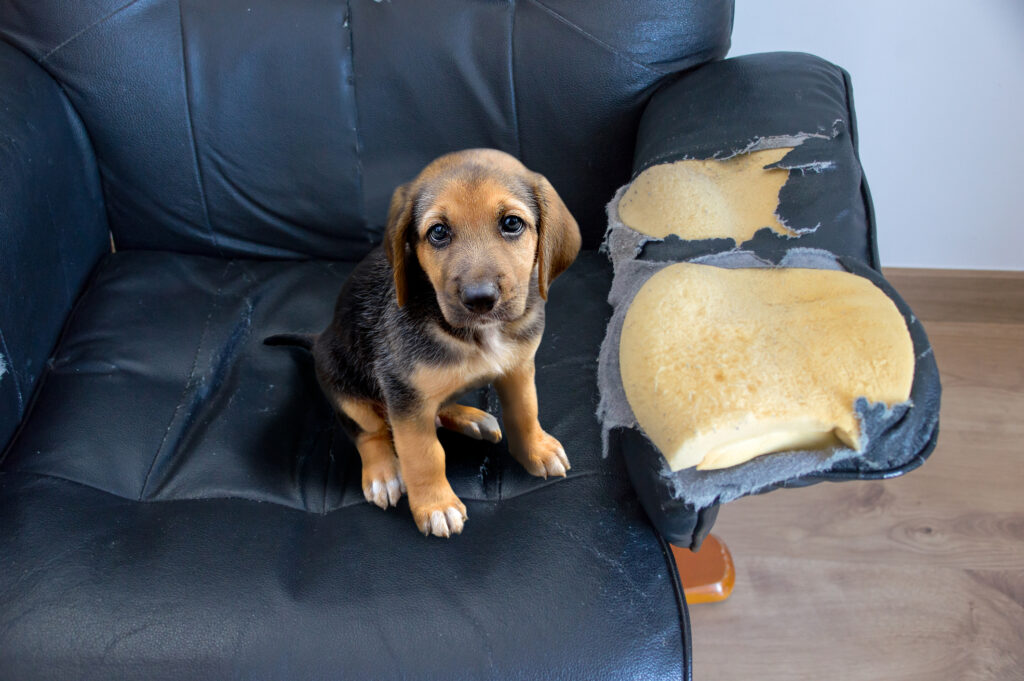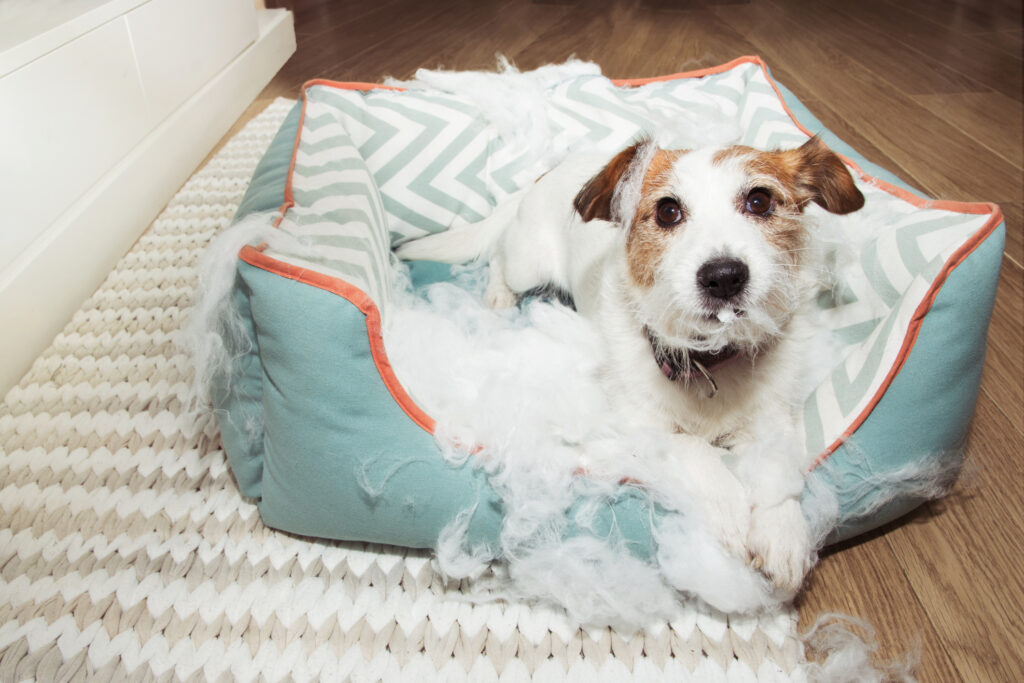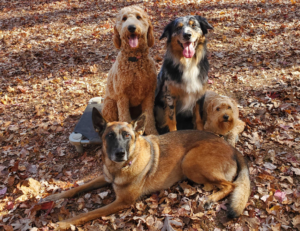Dogs are affectionate, loving members of our families, but sometimes their behavior can become destructive and cause damage to household items and personal belongings. This type of behavior is often frustrating for humans, but perhaps more importantly, it can be dangerous for your dog’s health.
There are many reasons why a dog might engage in destructive behavior. In this article, we’ll explore the reasons behind destructive dog behavior to help provide an understanding of these problematic acts.
Examples of destructive dog behavior
There are various ways a dog might engage in destructive behavior. The most common examples of destructive dog behaviors include:
- Chewing
- Digging
- Barking
- Jumping
- Other unusual acts that are destructive in nature.
All of these can be problematic for dog owners. Chewing destroys valuables; digging ruins the floor and your yard; barking disturbs neighbors; and so on. These acts need an understanding of why they occur in the first place to prevent them from happening. While your dog may seem like a vicious furball intent on destroying anything in their way, the reason behind these behaviors may be simpler than you think.

What causes destructive behavior?
There are several reasons why a dog might be engaging in destructive behavior.
The reasons can be as simple as teething in puppies who want to chew everything around them to relieve pain and discomfort. While this behavior mostly stops after permanent teeth grow, it may continue into adulthood. Chewing helps the dog to explore the world around them, so redirecting them to something appropriate for chewing (such as a chew toy) is the best thing to do.
For adult dogs, the reason for destructive behavior varies. Medical problems, separation anxiety, attention seeking, fear, and boredom are the most common reasons for destructive dog behavior. These problems usually arise from a lack of exercise, mental stimulation, or training. In severe cases, the behavior has a much more complex reason behind it, such as family history and genetics, phobias, or traumatic experiences.
Regardless of the cause, dogs don’t suddenly decide to choose violence and start vandalizing the world around them. Dogs engage in destructive behavior because they need an outlet to release excess energy, or to relieve fear and anxiety. Just as people exercise or chew gum to relieve anxiousness, dogs react by chewing, jumping or barking.
How to stop destructive dog behavior
Preventing destructive dog behavior starts with an understanding of why the dog is acting this way. Locating the cause helps you to assess the situation and makes finding a solution to the problem easier.
Taking action before destructive behavior becomes a habit is a must. Here are some practical tips on stopping and preventing destructive dog behavior:
- Dog proof your home: Put away any items you feel are valuable to you in places your dog cannot reach. This will reduce the chances of valuable items being damaged and give you a cleaner field to manage the destructive behavior.
- Supervise your dog: Keep an eye on your dog while you’re home to make sure any destructive behavior won’t go unnoticed. Supervising also esnures you can guide and redirect the dog to encourage appropriate behavior.
- Provide chew toys: Dogs chew – it’s nothing unusual. Giving them safe chew toys puts them in the right direction. It teaches what they can and cannot chew. However, they should only have one or two chew toys at once. They may think anything on the ground is up for grabs if there are too many toys on the floor, and will consequently start chewing on things they shouldn’t.
- Provide enough exercise: A tired dog is a happy dog. Dogs who don’t get adequate physical exercise may become restless, and that is typically when the destructive acts begin. If a dog is tired, they will have a reduced urge to destroy things and spend their time at home resting and relaxing instead.
- Challenge your dog: Providing mental stimulation is just as important as physical exercise. Mental stimulation lowers stress levels, helps them learn, and tires them quickly, even more so than physical effort. Interactive toys, socialization, scent work, training sessions, and playtime with other dogs are all great means of providing mental stimulation. These keep their mind busy and reduce the desire to act destructively.
- Train your dog: Regular training sessions can provide the mental stimulation dogs need, but it also makes them disciplined by teaching them right from wrong. Any form of training, from obedience to agility, can help reduce destructive behavior while earning you respect, making it easier to curb unwanted acts.
- Avoid punishment: Lastly, avoid punishment as a way to stop your dog’s behavior. Punishing only worsens destructive behavior, and can escalate a situation with a dog who is already looking for an outlet to deal with frustration or anxiety.

When to get professional help for your dog
The root cause of the destructive behavior can be much more complex than the average dog owner might be able to understand. Traumatic experiences, phobias, and severe lack of socialization may require professional assistance from a canine behaviorist.
The destructive dog behavior can also get so severe that it becomes impossible for the owner to address it. The dog may not show improvement even after utilizing appropriate dog training techniques and taking the necessary precautions at home. In these cases, it is best to consult a professional dog trainer to know what behavior modification techniques would work best to address the issue.
Conclusion
Dogs who engage in destructive behavior often have a good reason behind it that needs to be addressed. Understanding why your dog engages in destructive behavior can often be difficult to grasp.
It is important for all dog owners to recognize the root cause of destructive behavior to address it effectively. Owners can help reduce these behaviors and promote a happy, healthy life for their dogs by providing them with enough exercise and mental stimulation, creating an ideal environment for training, and seeking professional help when necessary.
This article was originally published on January 11, 2014, and was updated on February 11, 2023.
Related posts

Mythbusting: Training Tools in Dog Training
In this article, we dispel some of the false narratives around the use of training tools in dog training.

Why One & Two Week Board And Train Programs Aren’t Effective
Some dog trainers claim that they can resolve complex behavioral issues in as little as one or two weeks. In this article, our Statesville dog trainer, Matt McKeown, dispels these myths and explains why patience, time and relationship-building are fundamental to successful dog training outcomes.

How To Build Confidence In Your Dog
Improving your dog’s confidence can lead to an increased quality of life – for both dogs and their owners. Discover strategies to increase your dog’s confidence.


You must be logged in to post a comment.